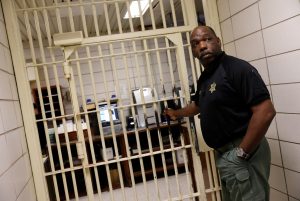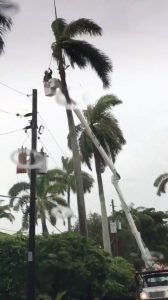
By Melissa Fares and Charles Levinson
EAST BATON ROUGE, La. (Reuters) – The East Baton Rouge Parish Prison, a squat brick building with low-slung ceilings and walls sometimes smeared with feces, is the face of a paradigm shift: penitentiaries as mental health care providers. Across the United States thousands of jails are sheltering a wave of inmates accused of crimes and serving time while suffering from illnesses ranging from depression to schizophrenia.
The shift is a byproduct of the plunging numbers housed in psychiatric inpatient treatment centers, a total that fell from 471,000 in 1970 to 170,000 by 2014. In Louisiana, the fallout exacerbated after a former governor shuttered or privatized a network of public hospitals that provided medical and psychiatric care to the accused.
East Baton Rouge Parish Prison is where Louis Jonathan Fano, afflicted with bipolar disorder and haunted by demons, found himself on Halloween Eve 2016 after fleeing a Greyhound Bus and wandering city streets naked and crazed.
Booked into the jail on six misdemeanor charges, Fano, 27, slit his wrists hours later. Then he was sent to solitary confinement, where he spent 92 of his 94 days imprisoned with his thoughts.
Midway through his jail ordeal, the parish handed responsibility for inmate medical care to a for-profit firm that decided Fano was “exaggerating his condition.” On January 18, 2017, it ordered him taken off his antipsychotic medication.
Two weeks later, the onetime veterinary student, who crafted letters to his mother in longhand, hanged himself.
His family rushed from California to find him unconscious in a hospital intensive care unit, where he lay until his death.
“We touched his cold hands. I talked to him but he had no life – it was just machines,” said his mother, Maria Olga Zavala. “Even with all that, they had him there handcuffed with a guard.”
Replaying that image inside her Southern California home, she asked: “Why wasn’t that guard in the jail, looking after my son before he took his own life?”
It’s a question asked often of the parish jail, where 25 inmates died from 2012-2016, at least five of whom were diagnosed with a serious mental illness or showed signs of one, jail and court records show. Fano became the sixth inmate since 2012 to die amid a mental health crisis; none had been convicted of the charges that jailed them.
From 2012 to 2016, the jail’s rate of death was 2.5 times above the national prison average, a Reuters analysis found. The East Baton Rouge Sheriff’s Office, which oversees the jail, blamed most deaths on drug use, “poor health and pre-existing conditions,” and noted Louisiana has long ranked low on public health metrics.
A private consultant hired to assess treatment found the jail was substantially understaffed, with 61 percent of the psychiatric staff hours found in comparable jails. Isolation units, transformed into de facto inpatient mental health wards, were “woefully inadequate physical environments for the most unstable mentally ill.”
Men on suicide watch were given paper gowns and no sheets or blankets, but the unit was kept so cold some inmates risked hypothermia. One sought warmth by squeezing himself inside the plastic covering of his mattress.
The East Baton Rouge Parish Prison is a vivid example of how local jails struggle to treat the masses of mentally ill filling their dank cells.
MENTALLY ILL AND INCARCERATED
Had a naked and hallucinating Fano stumbled off the Greyhound Bus a few years earlier, he likely would have received treatment at Baton Rouge’s Earl K. Long charity hospital. In the two years before its closure in April 2013, police brought 1,800 mentally disturbed detainees there for treatment, said Jan Kasofsky, Baton Rouge’s top mental health official.
Earl K. Long was part of Louisiana’s network of 10 public charity hospitals that provided medical and psychiatric care to the poor and the imprisoned. It cost the state $76 million a year to treat prisoners in these hospitals. In the spring of 2013, former Governor Bobby Jindal began privatizing or closing nine of the 10 and that $76 million cost has since been cut by two-thirds, said Raman Singh, until recently the corrections department’s medical director.
Jindal declined interview requests. Timmy Teepell, chief of staff during much of the Republican’s first term, said the system was closed for good reason.
“It was outdated, underfunded, and produced the nation’s worst healthcare results,” Teepell said. “I am surprised it lasted as long as it did into the 21st Century.”
But the shutting of the hospitals left local governments struggling to provide medical care behind bars. Cat Roule, who spent 12 years as a nurse supervisor at the East Baton Rouge Parish Prison, told Reuters, “Once Earl K. Long shut down, everything got much worse. There were people piling up in the intake unit. It was just madness.”
Dennis Grimes, the current warden, acknowledged the jail can’t properly treat those in need in a facility where some 800-900 of 1,500 inmates are currently on mental health medication.
“The prison is equipped to deal with disciplinary behavior, not mental health patients. It doesn’t have the things that it really needs in order to function for those who have a mental health problem.”
Medical staff, he said, “burn out, they don’t know what to do, they need some relief – and there are no mental health hospitals out there.”
FIVE MEN IN CRISIS WHO DIED IN JAIL
On February 13, 2013, as operations at Earl K. Long wound down, David O’Quin, a 41-year-old paranoid schizophrenic, was picked up by police after his father reported he was off his medications and behaving erratically. He was booked into East Baton Rouge jail on charges of disturbing the peace. Per jail policy for the mentally ill, he was placed in isolation, where inmates have little access to visitors and spend 23½ hours a day, court records show.
When O’Quin disobeyed orders, guards strapped him to a chair by his ankles and wrists and left him caked in feces and urine, the family alleged in a lawsuit. A jail nurse noted he suffered “serious psychosis” and needed to see a doctor. He didn’t see one for six days, the family said. Guards found him nude in his cell, ignoring orders and spitting, and stormed the cell with shields and mace, records say.
A day later, the jail’s psychiatrist diagnosed him suffering from serious psychosis. O’Quin spent much of the next seven days restrained to a chair in isolation. He died in that chair February 26.
An autopsy found he had died from a pulmonary embolism from a blood clot that developed in his lower legs, likely due to the prolonged period of restraint, as well as from bacterial infection likely from contact between his open wounds and feces. O’Quin’s family has reached an undisclosed lawsuit settlement with the sheriff’s office.
After his death, the sheriff’s office reviewed policies and procedures, said Casey Hicks, a spokeswoman for the East Baton Rouge Sheriff’s Office. Among the changes: new guidelines for using the restraint chair. “It is still used when necessary, though it now requires approval directly from the Warden or designee,” she wrote.
Howell Andrews, a Senior Special Assistant to the Parish Attorney of East Baton Rouge, which was responsible for jail medical care at the time, pointed to a review panel’s findings: “The personnel of the Prison Medical Services acted within the standard of care within the regulations and restrictions in place in this environment.”
In July 2014, Antwoin Harden, 28, was picked up by police for trespassing on the grounds of the Drury Inn, telling officers he was homeless and would rather be in jail than on the streets. In jail, Harden refused to take his medication for bipolar disorder and sickle cell anemia, said his mother, Angelo Moses. He died that month from a blood clot in his lung, related to not taking his medications, she said.
Citing confidentiality restrictions, Andrews said he could not discuss Harden’s case. But he noted: “We are unable to forcibly medicate the individuals.”
Months later, on September 19, 2014, 72-year-old Paul Cleveland was arrested after verbally threatening a court clerk and booked into the jail. On his intake forms, the nurse noted he was bipolar and on antipsychotic medications, and suffered maladies including diabetes, heart pain and rheumatoid arthritis.
Once inside, Cleveland was unable to stand in the hours-long line for patient medications due to his arthritis. His doctor sent a note to the jail saying Cleveland needed a wheelchair, and his family brought one to the front gates. But jailers never let it inside, according to court filings in a family lawsuit against the city, jail and sheriff.
Cleveland filed eight emergency medical request forms, complaining of chest pain, trouble walking to get medication, and suicidal thoughts. When he felt the requests went unheeded, he filed three formal grievances.
Once, a doctor refused to see him because he was behaving belligerently, his medical records show. Other pleas were dismissed as the ranting of a madman. “Banging on window,” said a nurse, who assigned him to a lockdown cell “for his own safety.”
Cleveland’s prescribed daily medications included the antipsychotic Seroquel, Metformin for diabetes, and Cardura for blood pressure. When he was unable to rise and walk to receive them, a jail nurse told him to “stop playing and come get your medication,” a guard testified as part of the family’s ongoing lawsuit.
“Look, they killin’ me,” Cleveland told his family, in his last jailhouse call. “I can’t hardly stand no more.”
At 2:32 the morning of November 12, deputies found Cleveland naked on the floor of his cell, covered in feces. He said he was too weak to shower. A nurse told guards Cleveland was faking “because he wants to get back to the infirmary,” a guard testified in a deposition. Two hours later, at 4:05 a.m., he was found dead in his cell. An autopsy found extensive gastrointestinal bleeding likely caused by cardiovascular disease.
“If he had been transported to the emergency room and received a very simple blood transfusion, he would have survived,” said his lawyer, Amy Newsom.
Hicks said the sheriff’s office took “appropriate action” in dealing with each of Cleveland’s medical requests.
East Baton Rouge city attorneys dispute the family’s allegations, saying Cleveland was treated by medical personnel between 15-17 times during his 50-day stay. His wheelchair was denied because there was no necessary medical approval, said the city, which disputed allegations he was too weak to take his medication.
On May 25, 2015, Lamar Johnson, 27, was pulled over by police because the windows of his Honda Accord were illegally tinted. It was a minor infraction, but Johnson had an outstanding warrant in a neighboring parish, a four-year-old charge for passing a bad $900 check.
He was booked into East Baton Rouge. When guards refused his request for a blanket, he cursed them, according to deposition testimony by two inmates in the family’s lawsuit against the city, parish, warden, sheriff and others. The guards beat Johnson, handcuffed him and pepper-sprayed him, the inmates testified.
Johnson had never been previously diagnosed with a mental illness, his family said. But in jail, his mental health took a turn. Eyewitnesses described him pacing and paranoid, muttering, “I don’t want to live.” The guards moved him to the jail’s isolation wing. “The further back you go, the worse it is, with the smell and the noise,” another inmate testified.
At 10:22 a.m. on May 30, Johnson was found hanging from cell bars. He died days later.
When his father, Karl Franks, sought answers, he said Warden Grimes had little to say. “Well, Mr. Franks, it is what it is,” Franks recounted.
The sheriff disputes allegations in the family’s lawsuit, Hicks said, finding “no evidence” Johnson expressed suicidal thoughts or had been beaten by guards.
Prison Medical Services, the city-run entity responsible for jail health care, said it was “never notified of his presence prior to being called to respond to his suicide,” Andrews said. An inmate log form, he said, showed Johnson’s name had been struck through and marked as “released.”
‘A TICKING TIME BOMB’
Johnson’s death was the fourth involving a mentally disturbed inmate since the closure of East Baton Rouge’s charity hospital. Political pressure was mounting. In August, jail medical personnel testified before council members at a public hearing.
A jail nurse, Sharon Allen, told the council the jail was filling up with mentally ill inmates and described how a nurse had to leave early because an inmate foisted feces at her. “These are mentally unstable people and there’s not enough nurses,” she said.
“We do have a ticking time bomb,” said Dr. Rani Whitfield, a top medical official at the jail.
In response, the council hired Chicago-based consultants Health Management Associates to conduct a $95,000 study of the jail’s medical services.
Before the consulting firm could finish its study, the death toll rose. This time, it was 17-year-old Tyrin Colbert, arrested in November 2015 at his high school for an alleged sexual assault of two younger boys. The waifish teen – standing 5’11” and weighing 129 pounds – reported feeling suicidal soon after he was booked.
Placed in isolation, Colbert said he was hearing voices and told medical staff he needed help, court records show. Dr. Robert Blanche, a psychiatrist contracted to work part time at the jail, assessed Colbert through the bars of his cell. “He is not suicidal; not depressed; he was manipulating,” Blanche noted in the jail’s electronic record-keeping system. He ordered the suicide watch discontinued.
Blanche did not respond to requests for comment. He, Sheriff Sid J. Gautreaux III and Warden Grimes are among defendants in the family’s lawsuit.
Four days later, another deputy said he found Colbert rocking back and forth and talking to a wall. Colbert said he had an imaginary friend named Jimmy. This time, Blanche concluded Colbert “may be psychotic (or he is malingering),” he wrote.
Hicks said Colbert requested to be taken off suicide watch. He returned to the general population and into a cell with another inmate, also 17, who choked him to death with a blanket on February 17, 2016. “Colbert did not report any threats or complaints concerning his cellmate,” said Hicks.
The private consulting firm’s findings, submitted to the Metro Council four months after this latest death, were damning.

Warden Dennis Grimes opens the doors to holding cells of the East Baton Rouge Parish Prison in Baton Rouge, Louisiana March 5, 2018. Picture taken March 5, 2018. REUTERS/Shannon Stapleton
PRIVATE FOR-PROFIT PRISON CARE
The jail had just 36 percent of the physician staff hours found in comparable facilities. Jail staff failed to distribute prescribed medications nearly 20 percent of the time. A powerful anti-psychotic was being used widely to treat routine insomnia and keep inmates docile.
HMA concluded East Baton Rouge would need to double its $5 million annual budget to meet the minimal standard of inmate medical and psychiatric care.
That didn’t happen.
Instead, on January 1, 2017, the city hired CorrectHealth LLC, a private for-profit firm specializing in prison health care. The Atlanta-based firm promised to bring the jail’s medical care up to standard for $5.2 million a year, half of what the consultant cited.
CorrectHealth is among at least a dozen U.S. firms specializing in for-profit medical care behind bars. Today, it holds contracts to provide inmate healthcare at more than 40 facilities in the southeast, a spokesman said.
When it took over medical care in East Baton Rouge, Fano had been there two months.

Jonathan Fano, who committed suicide while in custody at East Baton Rouge Parish Prison is pictured in this undated handout photo obtained by Reuters May 15, 2018. Vanessa Fano/Handout via REUTERS
His jail journey began as the Greyhound Bus idled at the Baton Rouge depot, amid a cross country journey from Miami to his California home. Sitting on the bus, he grew deeply paranoid.
“He said that all the people on the bus knew what he was thinking, that they were judging him, and that he felt sick,” recalled his mother. Fano, showing signs of schizophrenia, sometimes cleared his mind by walking the streets so long his bare feet blistered.
“‘Just focus your mind on coming home, don’t look at anyone, stay calm,’” Zavala told her son.
He fled the bus. Hours later, Baton Rouge police found him wandering the streets “naked and running around … hollering and cussing at imaginary people” and tearing down mailboxes, an arresting officer wrote.
Locked up, he begged for help. He filled out a medical request form November 25, 2016, complaining of anxiety and saying his antipsychotic meds weren’t working. “Feels as if the walls are closing in,” he wrote in December. Soon, a guard noted in all-caps that Fano “NEEDS TO SEE PSYCH.”
CorrectHealth took over New Year’s Day 2017. On January 11, an employee wrote Fano was “faking bad or exaggerating his condition.” Psychiatrist Blanche assessed Fano through the bars of his cell, concluding he “doubts serious mental illness, will begin tapering meds.” He ordered Fano’s anti-psychotic medicine reduced to 5mg and then discontinued after a week.
On February 2, Fano was found hanging from a torn mattress cover knotted to the bars of his cell. Under jail policy, the warden said, guards are supposed to check on inmates on suicide watch every 15 minutes and document what they see. But such checks didn’t come for Fano in the 11 hours before he hanged himself, video reviewed by Reuters shows. The reason: The warden said medical staff had months earlier taken Fano off suicide watch.
He died three days later. His mother now visits his grave every week.
John Ritter, a spokesman for CorrectHealth, said the company could not comment on pending litigation. He said company-run facilities “have been successfully audited against national correctional healthcare standards on numerous occasions.”
Warden Grimes defended the jail’s policy of placing inmates in isolation. But he said he had no easy answers to the jail’s challenges.
“The only way you’re going to stop someone from killing themselves is if there’s an officer there monitoring them 24/7,” the warden said. “And that’s just not possible.”
REFORM THAT LIVES AND DIES WITH POLITICS
As the deaths mounted, some city leaders began to feel pressure. O’Quin, whose last breaths came in a restraint chair, was from a prominent philanthropic Baton Rouge family. His father, Bill O’Quin, former president of a financial services publishing firm, mobilized business interests who joined the city’s first African-American mayor, Kip Holden, to push for a solution.
They drafted a plan to build a new mental health treatment center that would take in mentally ill people picked up by police. The center was modeled after one in Bexar County, Texas, where the sheriff said the facility saved the county $50 million over five years thanks in part to a sharp drop in incarceration rates of the mentally ill.
In Baton Rouge, winning approval for a tax to fund the center required support of the 12-member East Baton Rouge Parish Metro Council. To muster support in the district, backers sought the endorsement of one of the parish’s most powerful forces: Sheriff Sid Gautreaux, who runs the East Baton Rouge Parish Prison. “If he didn’t support it, then our prospects were zero,” said William Daniel, former chief of staff to then-Mayor Holden.
Gautreaux is a tough-talking career lawman who had long pushed the city to bankroll a new jail. “The plan was, let’s give the sheriff a new jail, and we’ll get our mental health center,” said John Davies, CEO of the Baton Rouge Area Foundation, a philanthropic development fund that was among the driving forces for the mental health center.
Negotiations took place in Gautreaux’s office, adorned with taxidermied hunting trophies, animal skin rugs, and crossed rifles inmates had carved from wood, said those present.
The sheriff wanted the largest parish jail in Louisiana, a 3,500 bed facility, more than double the current size, attendees said. Mental health center supporters pushed back. Crime had been on the decline in Baton Rouge, they argued. Plus, the mental health center would divert many inmates from jail, citing the Texas example.
In Louisiana, sometimes dubbed the “world’s prison capital,” filling jailhouse beds means big money for sheriff’s offices. Any Louisiana sheriff with capacity to spare can house state prisoners and receive a fee of about $24 a day per inmate. Over 50 percent of Louisiana state prisoners are held in local jails, far more than in other states. Sheriffs boost their budgets by hiring out inmates as cafeteria workers at the statehouse, for instance.
“In Louisiana, anytime you want to pass a law moderating the drive to imprison people, you have this almost insurmountable opposition from the sheriffs,” said Jon Wool, with the Vera Institute for Justice, a nonprofit opposing mass incarceration.
Hicks said Gautreaux backed the mental health center from the start, and that the new jail size was determined by outside consultants. “The sheriff did not demand any particular size of the jail,” she said.
In the end, the package that went to the 12-member council for a vote in January 2015 included a 2,500-bed jail and package of new criminal justice facilities.
Advocates thought they had wrangled just enough support from the council’s tax-wary Republicans to endorse a $330 million bond measure. But at the last minute came defections from key Democrats. “This was just difficult to swallow with such a large prison component,” said council member Tara Wicker.
A mental health center was put again to a standalone citywide vote in 2016. It narrowly lost.
(Additional reporting by Ned Parker, Linda So and Grant Smith. Editing by Ronnie Greene)













